Multidirectional Memories and Transnational Solidarities in Exile: AMA y No Olvida, Memory Museum Against Impunity
Emilia Yang
February 2024
La memoria es sobre todo acto, ejercicio, y práctica colectiva.
Memory is above all action, exercise, and collective practice.
— Pilar Calveiro, “Los usos políticos de la memoria” (2006)1
This essay narrates a story about pain, rage, and trauma that affects people who live under extreme conditions of state-organized violence – but it is also about strategies of caring, learning, and creating memory work in the community. Like countless Nicaraguans and Central Americans, I experienced state violence in a personal and devastating way when government-sponsored paramilitaries murdered my uncle Vicente Rappaccioli near our house in Carazo, Nicaragua on June 26, 2018. As in the cases of all the other victims following the 2018 popular uprisings, his case continues with impunity. In my body and memory, I thread the political history of my family’s exile for my grandfather’s political activism with my most recent exile.
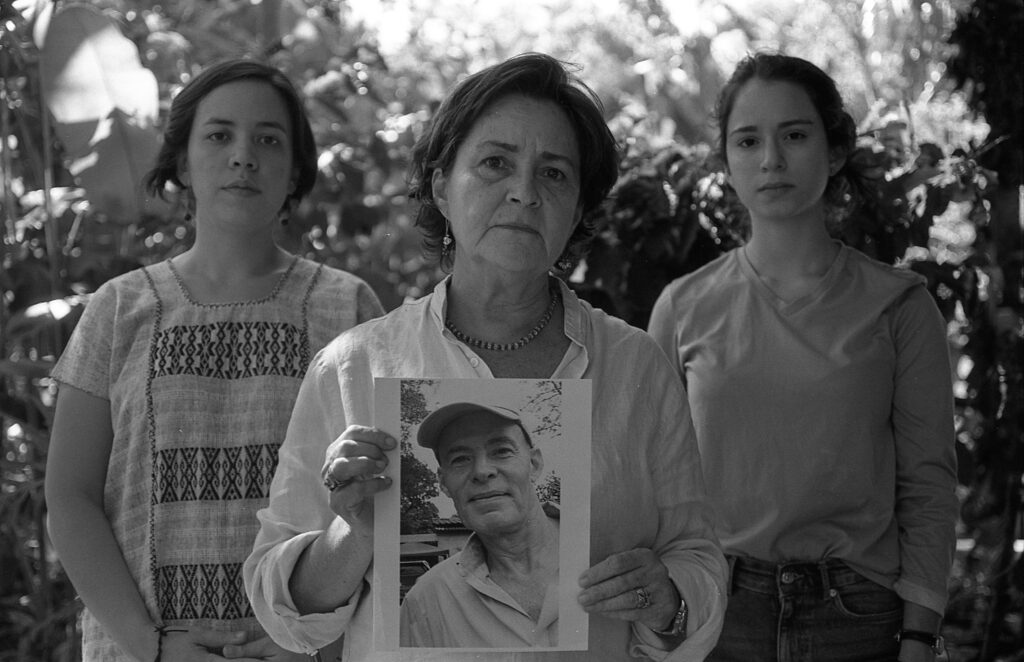
Victim: Vicente Rappaccioli Navas, 60 years old, business administrator assassinated in Las Cuatro Esquinas, Carazo on June 26, 2018. Relatives: Emilia Yang Rappaccioli, Luvy Margarita Rappaccioli Navas, and Luisa Pérez de la Rocha Rappaccioli. Photo: AMA y No Olvida, Museum of Memory Against Impunity
When writing this text, I position myself as a transfeminist, middle-class, cisgender, queer, mixed-race, mestiza woman with Asian, European, and Indigenous roots from Central America and family links to Nicaragua and Costa Rica. My native language is Spanish, but I have the privilege of speaking English and having attended graduate school in the United States. I also want to acknowledge that my positionality differentiates me from many victims who suffer greater forms of structural violence, especially those of Indigenous and African descent.
In this essay, as in my creative practice, I carry out an exercise in counter-memory, far from a constructed monumental and patriarchal memory that subdues and makes invisible the memory of women, queers, Indigenous and Black folks, and those who have been impoverished and subjugated.2 Through my work, I take an active stance that highlights the work and memories of these communities and actively builds community and resistance networks.
Post-Revolutionary Nicaragua
Nicaragua has been experiencing an authoritarian consolidation since former revolutionary leader Daniel Ortega returned to power in 2007. He was a commander of the Sandinista Popular Revolution that took place in 1979, coordinator of the Junta of National Reconstruction (1979–1985), and President of Nicaragua from 1985–1990. During this period, a civil war was waged between the Sandinista Popular Army and the counter-revolutionary forces supported by the United States government. Afterward, there was a transition to a so-called democratic government in 1990 led by Violeta Barrios de Chamorro, which was followed by a neoliberalization of the state and the economy, leading to different forms of social abandonment with the cut of social programs (education and health care) and the privatization of state enterprises. After the Sandinista Party lost the elections in 1990 during a new wave of conservative politics and efforts of erasure of any traces of the Revolution, the idea of collective memory implied the defense of the Sandinista Revolution under the control of the Sandinista Party and the ideas that shaped that project, without looking critically at its own harms and excesses.3
Ortega came back to power in 2007, paradoxically, by fostering alliances with his old alleged enemies (big capital, counter-revolutionaries, and the Catholic Church) that were sustaining and furthering the neoliberalization process. He developed a deeply conservative regime based on nepotism, with his wife, Rosario Murillo, as the Vice President and spokesperson for both the government and the Sandinista Party, and all ten of his children in positions of power, managing communication outlets and international investments. Some of the issues that have caused popular discontent in the nearly two decades of his rule have been the concession of Nicaraguan territory to a Chinese entrepreneur to build an interoceanic canal, the banning of abortion under any circumstances, extractivist and anti-labor policies, and the severe restriction of any type of protest or demonstration.
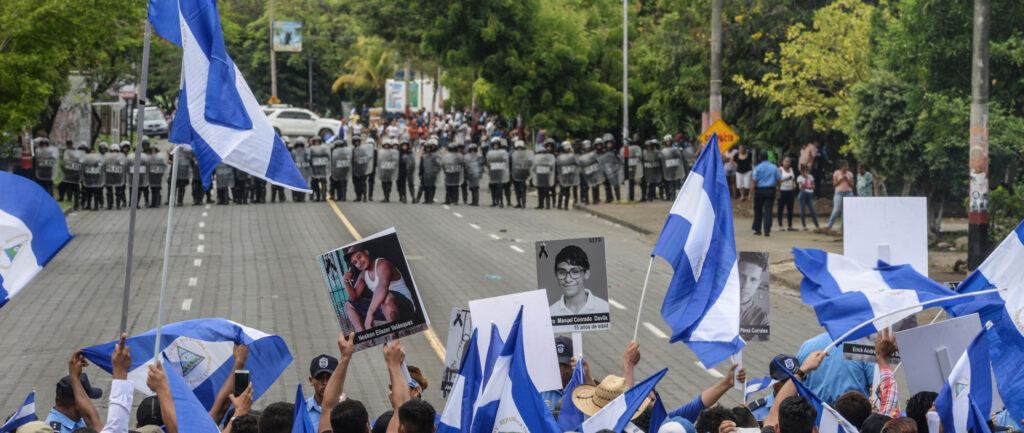
Nicaragua: Authorities unleash a lethal strategy of repression against protesters. Photo: Wilmer Lopez/Amnesty International
2018 April Uprisings
In 2018, nationwide protests erupted in Nicaragua in response to an International Monetary Fund (IMF)-mandated reform of the Nicaraguan Social Security Institute (Instituto Nicaragüense de Seguridad Social, or INSS) following mismanagement of the funds by President Daniel Ortega’s government. “Uprisings,” as the Mexican scholar Rossana Reguillo Cruz describes them, “emerge there, where the affected bodies, capable of naming their affection, recognize themselves in a crowd that interrupts the machinery of the proprietary powers.”4 The first to protest were elders who had their pensions reduced, and when they were repressed and physically attacked, university students joined and those in public universities occupied their campuses. The government organized police and pro-government paramilitary groups to use lethal force against the protestors, killing almost 500 people in under five months. These events ignited a nationwide uprising that lasted several months. International human rights organizations characterized the government’s repressive response as “crimes against humanity.”5
The government actively denied its responsibility for the events, impeded mourning in public space, and violated the right to truth and justice by criminalizing and dehumanizing protestors and victims. Government spokesperson Rosario Murillo referred to the protestors and political prisoners as “terrorists,” “delinquents,” “pests,” and “vermin.”6 Currently, international human rights organizations have been expelled and human rights violations continue to happen with impunity in a police state with draconian laws criminalizing all forms of dissent. The government continues its repressive tactics of imprisonment, kidnapping, banishment, confiscation of organizations’ buildings and personal houses of social leaders, and stripping social movement leaders, politicians, journalists, academics, and feminists of their nationality. Consequently, more than 600,000 Nicaraguans, like me, have fled and gone into exile to save their lives.7
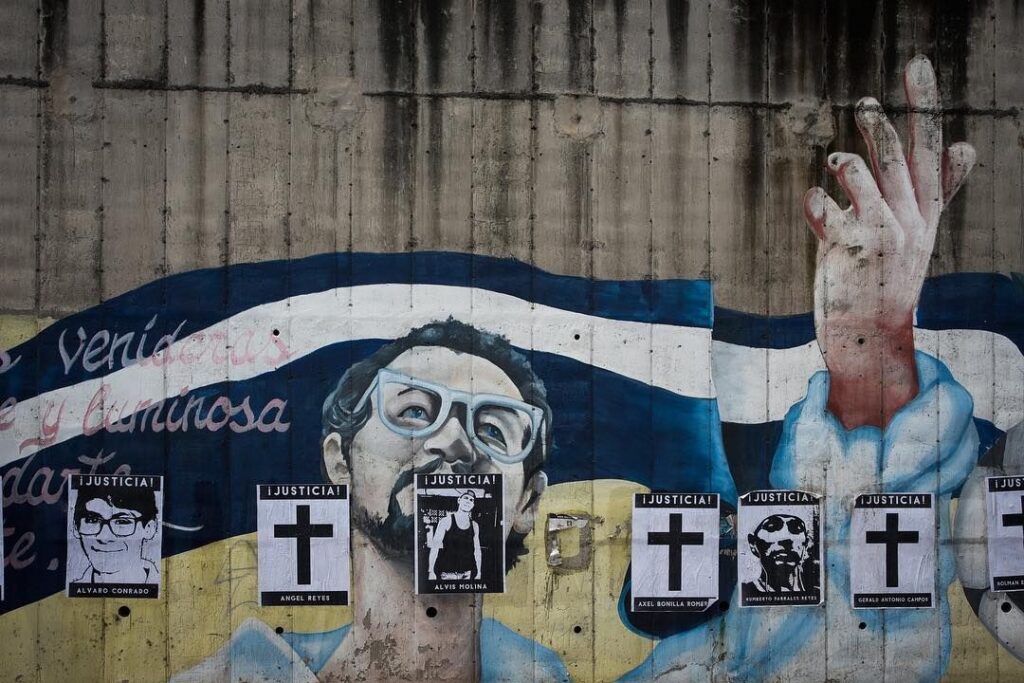
Image taken on July 12, 2018, showing posters with the faces of the victims of the repression. Photo: Carlos Herrera/Confidencial Digital
During the 2018 uprisings, many artists, as myself, did public interventions to challenge the ban on public mourning and to demand justice for the killings of the victims. In the image above, posters with images of state victims killed in the name of the “defense of the revolution” were placed over the face of the Sandinista Party founder and “Father of the Revolution” Carlos Fonseca, painted by the government. This artwork was located on Jean Paul Genie Avenue, which crosses the capital city of Managua and was the pathway of many protests and marches, and allowed for the families of the victims and protestors to turn it into a temporary altar or memorial site. Ironically, the street was named after a young man who was killed in the 1990s by the bodyguards of Humberto Ortega, head of the Sandinista Popular Army in 1990.
The image above represents the contestation of public space in Nicaragua by the government and activists, as well as how the concept of multidirectional memories operates in the country.8 As Michael Rothberg describes in his book Multidirectional Memory (2009), memories are “subject to ongoing negotiation, cross-referencing, and borrowing; as productive and not privative.”9 In this case, this public intervention asks: How can we deal with this heroic revolutionary past that is being used to justify the killing of young people who live in the precarious conditions that the revolution sought to change? During this uprising, young people would re-signify and re-occupy the revolutionary symbols of power.10 Scholar-activists Irene Agudelo Builes and Jessica Martínez-Cruz see these actions as repetition, as a return to a common place, or as memories transmitted by parents and grandparents who lived through the revolution and the insurrection against the previous dictator Somoza,11 as “post-memories.”12 The historic and revolutionary symbols and practices of resistance against mass violence became present, activated by new actors, in this time of upheaval.
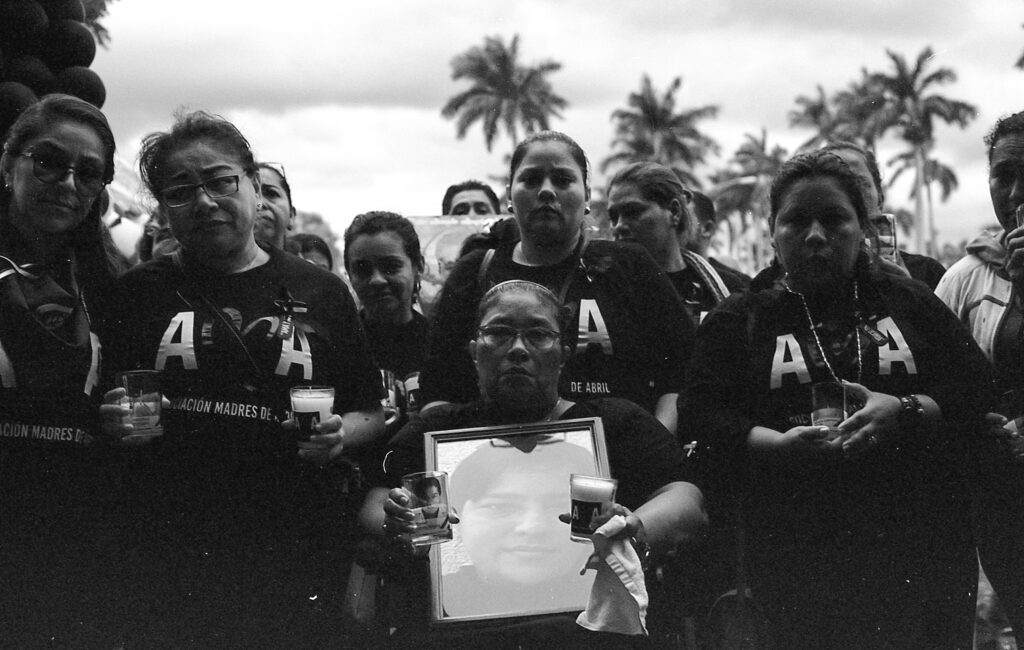
AMA, Mother’s Day, May 30, 2019, Managua Cathedral. Photo: Camaleoni
Loving and Not Forgetting: Research and Transmedia Archival Documentation
The Mothers of April Association (Asociación Madres de Abril or AMA, which also translates to “love”) is an association in search of truth, justice, and integral reparations that unites and represents mothers and relatives of the people assassinated by the state repression in Nicaragua since 2018. Amid police brutality, persecution, and grieving, we raised our voices to demand that state authorities and international human rights organizations investigate the events that occurred and continue to occur. AMA is part of a lineage of parents whose children have been killed by government forces and who have tried to publicly seek justice inside the country and abroad.13 During the revolution, The Mothers of Heroes and Martyrs (Las Madres de Héroes y Mártires) were mobilized as symbols and political actors by the revolutionary government in Nicaragua.14 Mothers of Plaza de Mayo in Argentina, the Parents of the Normalistas de Ayotzinapa and forced disappeared by the narco-state in Mexico, Madres of Falsos Positivos in Colombia, and many others have collectivized their pleas in public space to defend life and memory during military dictatorships and states of exception. I also include in this lineage the experiences of parents of victims of racialized police brutality as part of the Movement for Black Lives in the United States.15 Thinking again about the multidirectionality of memories, AMA and the movements of families of victims across the Americas share the repertoire of using photographs of victims on our bodies through garments and creating and sustaining communities and spaces of memory. The work of collectivizing these memories through different media has made it possible to connect and build a transnational network to continue to mobilize for justice and building solidarity abroad.
AMA y No Olvida (Love and Do Not Forget), Memory Museum Against Impunity is a project I created in collaboration with AMA, the Nicaraguan Center for Human Rights (CENIDH), and the Nicaraguan Academy of Sciences, with a human rights and participatory framework.16 The objectives of this museum are to create a community archive of the events, to create a memorial to honor and dignify the memory of the victims, and to organize to challenge the impunity of the government. This transmedia project includes a traveling exhibition along with an online archive that hosts over 200 video interviews, a photographic archive, memory artifacts, and hand-drawn maps that were turned into Geographic Information Systems (GIS) digital maps that geo-localize the narratives of the murders of 100 victims, as well as an Interactive Art Book (AR) experience that connects the stories of the victims with 3D artifacts.17
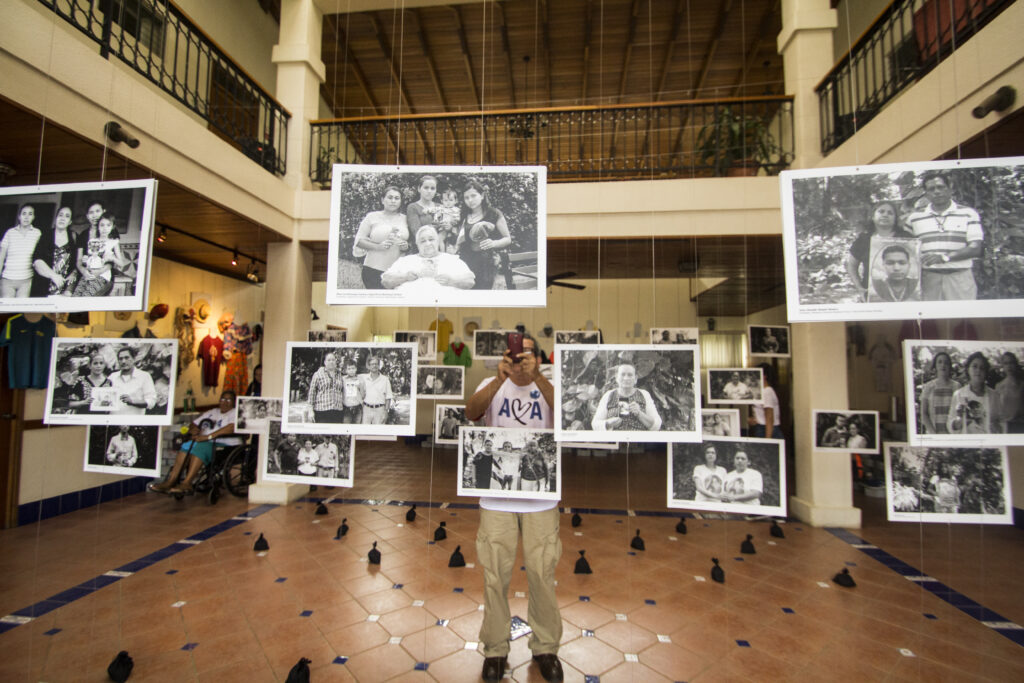
Photographic installation as part of a temporary exhibition, AMA y No Olvida, Memory Museum Against Impunity, 2019. Institute of History of Nicaragua and Central America (IHNCA), University of Central America (UCA) Archive. Photo: AMA y No Olvida, Memory Museum Against Impunity
The process of reconstructing memories about recent events has opened and rekindled previous memories and grievances about the violence in the 1970s and 80s. Many of the mothers’ testimonies that are part of the archive of the museum project mention how they had lost family members in these previous episodes of violence and how they now demand a different approach, both to the treatment of families of victims and to the memories of their loved ones. Enrieth Martínez, in her close reading of the testimonies of the victims of 2018,18 sees an “exemplary use of memory”19 that broadens the notion of memory and justice by articulating various processes of mourning of the victims within their own families, from the revolutionary and contra-war period to the recent uprisings.
When I think of this activist, conceptual, and community museum project, I also think about the imaginary museum, or museum without walls, of André Malroux (1947) and critical museology20 – differentiating it from museums of memory created by nation-states after periods of transitional justice that fabricate facts, subject formation, and state construction. One of the museum’s intentions is an autonomous, non-partisan counter-monumentalizing that is not based on the narrative of heroic courage and revolutionary strength, but on the lives of the victims and the sustained search for justice for their families. We try to create temporary spaces for memory that open reflexive conversations in which members of AMA can share their experiences and invite others from Nicaragua and elsewhere to join our collective path.
One of the reflections we bring forth is that as victims and survivors, we do not want to be the sole owners and keepers of memory; instead, we want it to sprout as a seed with a potential rhizomatic growth.21 This project became my way to process the trauma, working in collaboration with many artists and people who are committed to truth and justice and to creating a resource for future processes of truth and justice. A recognition that this terror not only happened to me, my family, and other families, but that it happened to us as a society, made the process of collectivizing and reproducing solidarity and empathy possible amid repression and mourning. The museum has become a source for journalistic projects, as well as a platform to create various experimental pedagogical and artistic workshops on human rights. Five years after the state-sponsored massacres and three years after the first exhibition in Nicaragua, this body of work continues to build collective memory in exile as a living and embodied history with Nicaraguan exiles and diaspora inhabiting artistic, political, cultural, and community spaces.
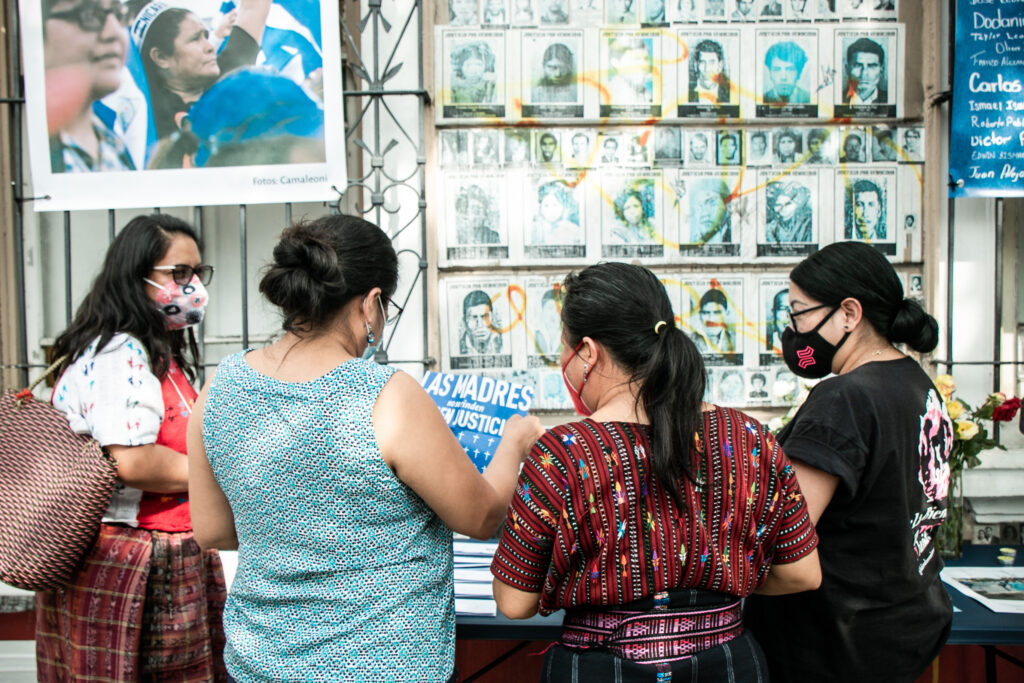
AMA y No Olvida, Museum of Memory Against Impunity at La Bienal en Resistencia, Guatemala, 2021. Photo: La Bienal en Resistencia
Transnational Solidarities in Exile
The best form of resistance to violence is not to face it alone, it is to come together, create more collective forms of life and reproduction, strengthen our ties, and thus truly create a resistance network that ends all this massacre.
— Silvia Federici (2018)22
Since the closing of the temporary exhibition in Managua in 2019, my exile, and the exile of many members of AMA, the AMA y No Olvida museum project has been presented in different exhibitions, art centers, urban interventions, and human rights events in Central America, the United States, and Europe. I notice how the multidirectionality of memories allows for people from other countries who are facing racialized, gendered, and necropolitical elimination strategies in the present and throughout time to connect with us and the project. For example, in Guatemala, during the La Bienal en Resistencia, we presented the traveling exhibition outside of La Casa de la Memoria Kaji Tulam, a place that examines the country’s history of oppression, highlighting human rights violations against – and the resistance of – peoples, all in support of the non-repetition of the serious violations in Guatemala. We also connect with transnational feminists and activists who were part of the International Solidarity during the revolution, who have renounced their historical solidarity with Ortega and opened the door to denounce the violence of his regime in international spaces. In one of these spaces, we presented the project with the founder of Comissió de la Dignitat in Barcelona, which calls for the conversion of the Superior Police Prefecture of Catalonia into a center for justice, reparation, and guarantees of non-repetition, democratic memory, and defense of human rights.
With these connections and many others,23 I follow Rothberg’s proposition of creating “visions that construct solidarity out of the specificities, overlaps, and echoes of different historical experiences.”24 Because of the longstanding histories of imperialism in our specific territories in the Global South and the politics of the diasporas of these countries, there is a need to confront the lack of nuance in how our circumstances are framed in the United States and the West. We have been gaslit by people who defend Ortega’s Sandinista project even after it has committed crimes against humanity, maintaining a complacent view of the situation and repeating the narrative that the uprising in Nicaragua was fostered by the United States, a claim that has been debunked by protestors, numerous scholars, and people who embrace a democratic left.25 I see it as a neocolonial way of thinking that does not take into consideration the experiences of people on the ground and erases the demands of transformation from the victims.
La Solidaridad es la ternura de los Pueblos.
Solidarity is the tenderness of the People.
— Gioconda Belli26
I would like to finish this essay by reflecting on what it means to build transnational grassroots solidarities conceptualizing memories as multidirectional, non-hegemonic, non-patriarchal, and non-state-sponsored. This position focuses on the victims’ testimonies and aims to work for the transformation and politicization of emotions in order to imagine a future where people live assuming our historical responsibilities without impunity. The specific case of Nicaragua, based on the actions of the mothers and relatives of victims, reveals that it is of profound urgency to actively criticize, dismantle, and abolish the police state and the violence and impunity it is afforded by the justice system that continues to iterate waves of mass violence throughout the history of the country. It is equally important to prioritize our embodied experiences and healing.
We have connected with the families of victims and memory workers in different countries, who have shared experiences of state violence and resistance, to create a large network that has made our work in exile possible. I believe that this threading of connections opens up the possibility of creating new tools for learning, growing, and building power as we form a transnational resistance network against patriarchal, authoritarian, and imperial regimes, against all these massacres. What might transnational feminist solidarities across communities facing state and settler colonial violence, dispossession, and forced displacement look like? I imagine interconnected futures with longer collective horizons for justice, in which we broaden our conceptions of social, racial, and gender justice, and open and sustain new paths of action.
Footnotes
- Pilar Calveiro, “Los usos políticos de la memoria,” in Sujetos sociales y nuevas formas de protesta en la historia reciente de América Latina (Buenos Aires: CLACSO, Consejo Latinoamericano de Ciencias Sociales, 2006), translation by the author.
- Rosi Braidotti, Transposiciones: Sobre La Ética Nómada (Barcelona: Gedisa, 2009).
- Maria Fernanda Soto Joya, “Nosotros? Sandinistas. Recuerdos de Revolución En La Frontera Agrícola de Nicaragua” (PhD. Diss, University of Texas, Austin, 2009).
- Rossana Reguillo, Paisajes Insurrectos: Jóvenes, Redes y Revueltas En El Otoño Civilizatorio (Ned Ediciones, 2017), 877, Kindle.
- See GIEI Nicaragua, “Report on the Violent Events that Took Place between April 18th and May 30th, 2018,” Human Rights Investigation, Nicaragua: Interdisciplinary Group of Independent Experts of the IACHR (Inter-American Human Rights Commission), December 2019; and The UN Group of Experts on Human Rights on Nicaragua, “Informe Del Grupo de Expertos En Derechos Humanos Sobre Nicaragua,” UN Human Rights Council, 2023, https://www.ohchr.org/en/press-releases/2023/03/nicaragua-crimes-against-humanity-being-committed-against-civilians.
- GIEI Nicaragua, “Report on the Violent Events that Took Place between April 18th and May 30th, 2018,” 224.
- Katherine Estrada Téllez, “Más de 588 000 Nicaragüenses Solicitaron Refugio En Los Últimos Cinco Años,” Confidencial Digital, June 21, 2023.
- In her research, Latin American scholar Margarita Vannini traces how places of memory have been built and destroyed by governments in different historical periods in Nicaragua, contesting the legitimacy of the discourse about what happened and foreclosing the possibilities of dialogue. See, for example, Margarita Vannini, Política y Memoria En Nicaragua. Resignificaciones y Borraduras En El Espacio Público (Guatemala City: F&G Editores, 2020).
- Michael Rothberg, Multidirectional Memory: Remembering the Holocaust in the Age of Decolonization (Stanford: Stanford University Press, 2009), 3.
- Irene Agudelo Builes and Jessica Martínez-Cruz, “Revueltas de Abril: Narrativas, Redes y Espacios En Disputa,” in Nicaragua 2018: La Insurrección Cívica de Abril (Managua, Nicaragua: Universidad Centroamericana, 2018), 27.
- The Somoza family is a political family that ruled Nicaragua as a dynasty backed by the United States for forty-three years – from 1936 to 1979 – and was overthrown by a popular coalition led by the Sandinista National Liberation Front (FSLN). For more information, see link.
- Marianne Hirsch, “The Generation of Postmemory,” Poetics Today 29, no. 1 (2008): 103–28.
- Recent cases include Elea Valle, a peasant woman in Nicaragua who has denounced the murder of her husband and two of her children at the hands of the army since 2017. See Inter-American Commission on Human Rights Resolution 10/2018 Precautionary Measure No. 884-17.
- Emilia Yang Rappaccioli, “Mujeres, Madres y Feministas En Nicaragua: Resistiendo a Través de La Construcción de La Memoria y La Lucha Contra La Impunidad,” in Feminismos, Memoria y Resistencia En América Latina, Tomo 2: Narrar Para No Olvidar: Memoria y Movimientos de Mujeres y Feministas, ed. Ana Gabriela Rincón, Rubio Velvet Romero García, and Araceli Calderón Cisneros (Tuxtla Gutiérrez, Mexico: CESMECA, 2022), 81–110.
- See Kimberlé Crenshaw and Andrea J Ritchie, Say Her Name: Resisting Police Brutality Against Black Women (New York: African American Policy Forum and Center for Intersectionality and Social Policy Studies, 2015) and Claudia Rankine, “The Condition of Black Life Is One of Mourning,” in Rebellious Mourning: The Collective Work of Grief, ed. Cindy Milstein (Chicago: AK Press, 2017).
- Both organizations lost their legal registration as the Nicaraguan Government has canceled more than 3,000 non-government organizations. See Amnesty International, “Attack on CENIDH Is a Blow for Human Rights,” December 12, 2018.; and United Nations Office of the High Commissioner for Human Rights, “Nicaragua’s Crackdown on Civil Society,” May 9, 2022.
- In other places I have emphasized the practices that the members of AMA undertook to create community and center ourselves and to challenge the media representation and the revictimization of our family members created by the government communication apparatus. I have also explored the transmedia universe created by the practices, and how each element helps transform the story of each victim into a collective experience. See, for example, Emilia Yang Rappaccioli, “AMA y No Olvida Collectivizing Memory Against Impunity: Transmedia Memory Practices, Modular Visibility, and Activist Participatory Design in Nicaragua,” International Journal of Communication 16 (2022): 309–330.
- Enrieth Martínez Palacios, “¡Exigimos Justicia! Una Aproximación a Las Elaboraciones Sobre Justicia y Memorias Desde AMA y No Olvida, Museo de La Memoria Contra La Impunidad,” Universidad Centroamericana UCA, forthcoming.
- Tzvetan Todorov, Los Abusos de La Memoria (Barcelona: Paidós Asterisco, 2000).
- Michael Lazzara, “Dos Propuestas de Conmemoración Pública: Londres 38 y El Museo de La Memoria y Los Derechos Humanos (Santiago de Chile),” A Contracorriente: Una Revista de Estudios Latinoamericanos 8, no. 3 (2011): 55–90.
- Gilles Deleuze and Félix Guattari, A Thousand Plateaus: Capitalism and Schizophrenia (Minneapolis: University of Minnesota Press, 1987).
- Silvia Federici, “Silvia Federici: ‘Crear una red de resistencia que ponga fin a esta masacre,’” Feminacida (blog), February 19, 2018, https://feminacida.com.ar/silvia-federici-crear-una.
- I want to name the following organizations and collectives that we have been in connection with: Museo de la Palabra y la Imagen, Londres 38, Casa Memoria José Domingo Cañas, Museo de la Memoria y DDHH, Coordinadora 8M, Retablos por la Memoria, Colectiva Vivas en la Memoria, Memorial Disperso, Feministas Auto-convocadas Barcelona, Asociación de Mujeres Malvaluna, The Archive of Public Protests, Taneen Working Group, as well as larger networks researching memory practices such as the From Multidirectional Memory to Multidirectional Moments (MDM) project that hosts this text, Central American Memory Network, Central American Collective Memory and Resistance Practices Working Group of the Latin American Council of Social Sciences (CLACSO), Transformative Memory Network at British Columbia, Canada, Federation of International Human Rights Museums (FIRHM), and artists, activists, and academics from across the world.
- Rothberg, Multidirectional Memory, 16.
- William I. Robinson, “Crisis in Nicaragua: Is the US Trying to Overthrow the Ortega-Murillo Government? (Part II),” NACLA, August 20, 2021, https://nacla.org/news/2021/08/18/crisis-nicaragua-overthrow.
- Gioconda Belli, “Ternura de los Pueblos,” reference from acceptance speech, Queen Sofia Poetry Award, 2024, https://youtu.be/XsR0vufWI40?t=1145.
Emilia Yang is an artist, organizer, researcher, and director of AMA y No Olvida, Museum of Memory Against Impunity from Nicaragua. Her research explores the role of memory, violence, emotions, performance, and participation in the political imagination. Her art practice utilizes expanded forms of digital media (XR, transmedia, web, interactive, films, archives, performance, games, and public interventions) for the creation of community-based feminist, anti-racist, and transformative justice projects and futures. She is currently an Assistant Professor of Art and Design at the University of Michigan’s Penny W. Stamps School of Art and Design, with a focus on Anti-Racism by Design.